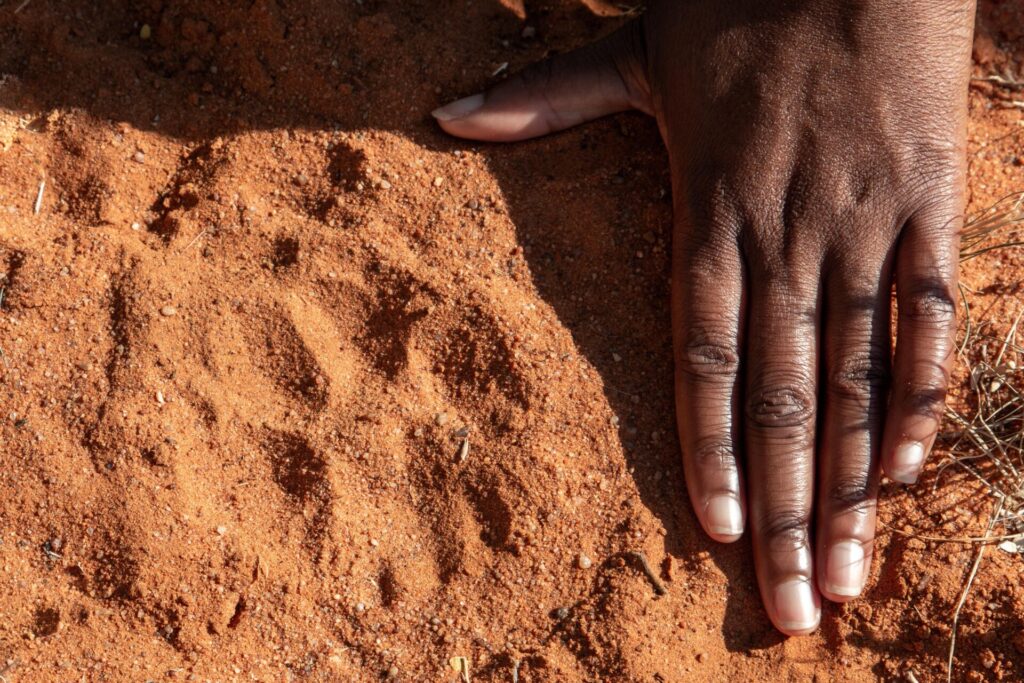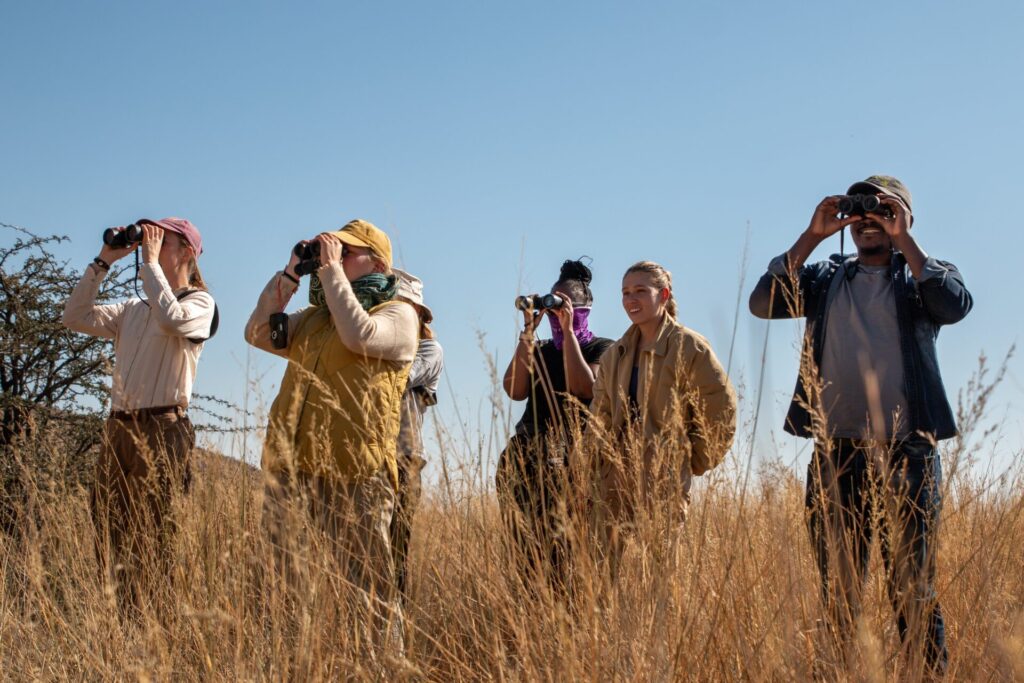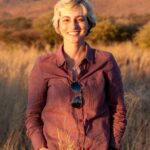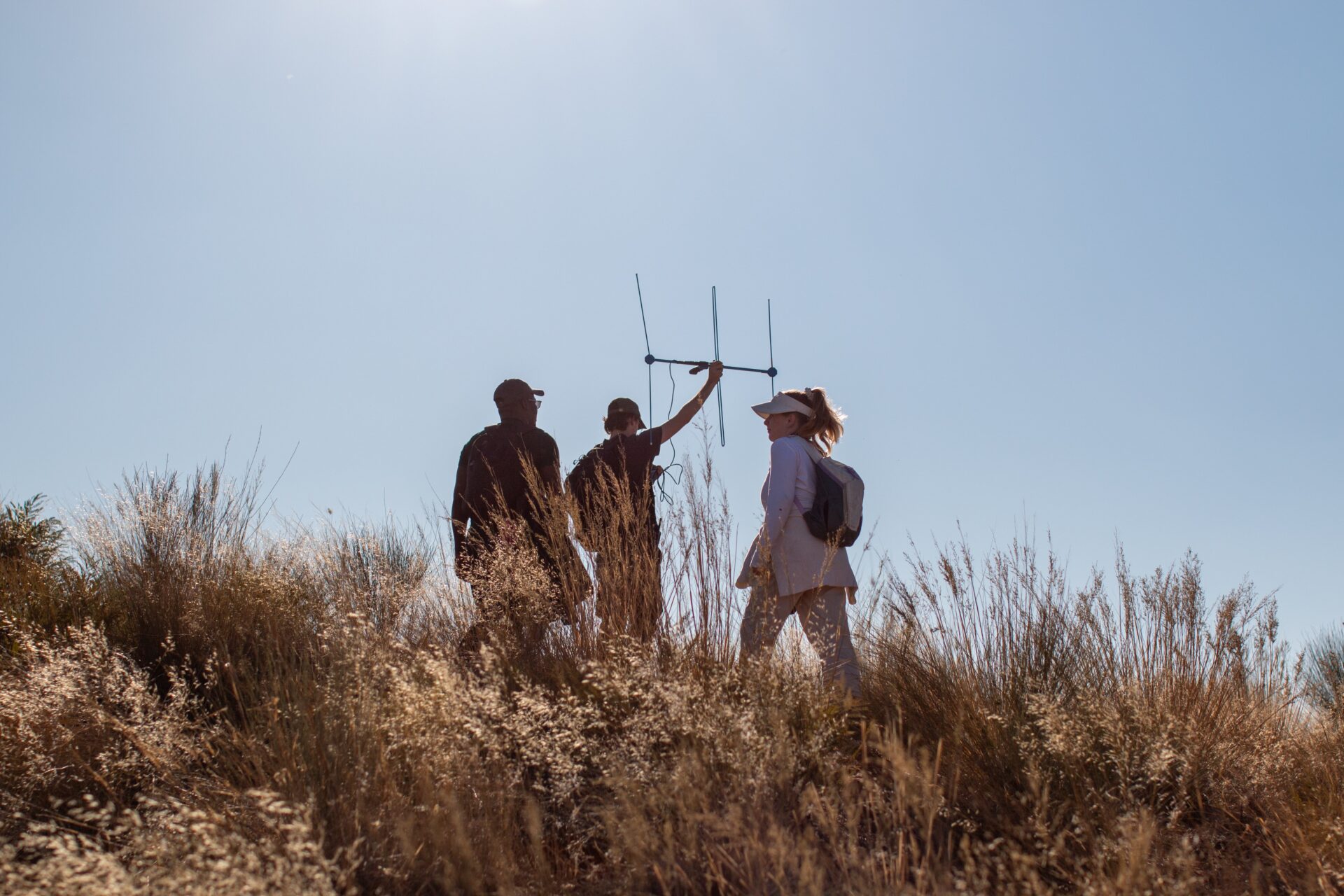Bridging theory and practice in the southern Kalahari
At its heart, conservation practice demands collaboration, innovation, and progress. Today’s conservationists must wield a diverse skill set, blending scientific expertise with the ability to communicate compellingly to both the public and policymakers. They must navigate group decision-making, design impactful programmes, and lead with critical thinking and problem-solving prowess. In essence, conservation thrives when partnerships bridge the gap between knowledge and action.
As the world faces mounting environmental challenges, conservation has transformed into a dynamic, interdisciplinary field, drawing on insights from economics, anthropology, sociology, and beyond. This evolution underscores the importance of hands-on learning, which not only sparks enthusiasm but also provides real-world context and exposes students to diverse career paths.

Master’s students Catharina Caspers and David Chapoloko join Wits master’s student, Benjamin Melamdowitz, in tracking a pangolin using telemetry.
At the University of Cape Town’s FitzPatrick Institute, this philosophy comes to life through the Conservation Biology Master’s Programme. Each year, Professor Robert Thomson, a passionate ornithologist specialising in the intricate dynamics of bird ecology, leads his students to Tswalu for an immersive field course. Amid the vast, rugged landscapes, classroom learning comes alive. For Professor Thomson, who has spent over a decade studying sociable weaver colonies and African pygmy falcons in the Kalahari, the experience fosters curiosity, camaraderie, and a genuine love for conservation.
“The Tswalu field course adds a really vital component to the training of these conservationists,” Thomson reflects, “by giving realistic understanding into conservation on the ground with all its challenges, but also all the successes and fulfilment of the work.”
For the students, it’s an exhilarating journey where science and adventure intersect, leaving an indelible mark on their understanding of the natural world. “In addition to developing research questions and collecting ecological data during the course,” he adds, “the students interact with reserve staff and other researchers, which provides insight into conservation management and experiences, as well as knowledge about their study systems. This exposure, combined with their existing motivation for learning and making a difference, is invaluable.”

Dembo Jatta, a Wildlife Conservation graduate and master’s student in the programme, recalls arriving at Tswalu in the evening. Despite the long journey, the calm of the vast landscapes and cool evening air provided a welcome respite. Their fieldwork included surveying mistletoes across the reserve, a task that brought them close to wildlife such as giraffes and kudus. But the true highlight was shadowing researchers housed at Dedeben Research Centre, whose studies of Temminck’s pangolin, cheetah and spotted and brown hyenas offered a privileged glimpse into the lives of these remarkable species.
Jatta shared, “One of the most memorable experiences was our visit with Ben to see the pangolins. His passion for his study and his deep knowledge about the pangolins left us truly impressed. Watching the pangolins in their natural habitat and learning about their behaviour and conservation was eye-opening. Similarly, our afternoon cheetah viewing with Elizabeth was just as exciting. Her insights into cheetah behaviour and her research were fascinating.”

Witnessing wildlife in its natural habitat demands patience, practice, and a profound respect for its space and behaviour. In winter, temperatures plummet after sunset, prompting many elusive species to emerge in the afternoon to forage, ensuring they secure enough food before the cold sets in. This makes late-winter afternoons an ideal time to spot a pangolin above ground, diligently searching for ants and termites. During milder hours, predators like cheetahs and African wild dogs can often be seen resting under trees or engaging in a hunt – a sight that never fails to thrill.
For Lesedi Moagi, who holds a diploma in Nature Conservation, her time at Tswalu surpassed all expectations. Moagi’s master’s research investigated how bird communities utilise sparrow weaver nests as resources at Tswalu. “The breathtaking Kalahari landscape, stunning sunsets, and diverse wildlife were unforgettable. I had the privilege of meeting researchers studying cheetahs, spotted hyenas, and pangolins at Tswalu. Joining them in the field enriched my understanding of their research and its impact on Tswalu’s conservation efforts,” she shares.
Professor Thomson remarks that the field course also provides students with an opportunity to witness his long-term study system in action: “The class also get to see me working on my long-term study system, something that gets me very excited, and hopefully this long-term perspective makes a mark on their perspectives too.”
“I have always been a keen learner, passionate to gather as much information as I can, in whichever capacity – although seeing things in practice and reality is the best source! I was able to witness many biological interactions that I had only learnt about in class or seen in documentaries. I think the trip truly was the best way to rejuvenate our group after many months in a classroom,” shared Keyura Pather, a climate activist and conservation ecologist pursuing a master’s in Conservation Biology.

Master’s students Atalante Itzicsohn, Catharina Caspers, Lesedi Moagi, Jade Simoen and David Chapoloko accompany PhD researcher Elizabeth Overton as she monitors cheetahs.
Catharina Caspers, another master’s student, agrees. “The research going on at Tswalu was fascinating and it was so lovely to interact with so many different researchers with different backgrounds and interests, even when just sitting at the boma around a braai. I learnt a lot about how research is done in practice and how much work goes into the knowledge they create,” she says. Caspers holds a bachelor’s degree in political science and adds to the multidisciplinary profile of this master’s cohort, which includes backgrounds in economics and finance, law and criminology, psychology, physiology, agriculture, and ecology. This diversity of expertise enriches the programme, fostering innovative approaches to conservation challenges.
For Natallie Psillos, with a master’s in Criminological Research, now studying for a master’s in Conservation Biology, the investigative abilities she honed will be employed in protecting natural environments. Psillos aspires to use her unique background in criminology in the wild to combat illegal activities targeting wildlife, blending her passion for justice with her commitment to conservation.
Similarly, Atalante Itzicsohn, with her background in economics, recognised that her knowledge offers a unique perspective that could bridge the gap between economics, finance, and conservation. Her goal is to create frameworks that promote effective conservation efforts and secure sustainable funding for critical projects. “I decided to use my finance and economics skills with a greater purpose and put them at the service of the preservation of the natural world,” she explains.
Jade Simoen, who holds a bachelor’s in Biology and Psychology, believes that the diverse backgrounds of her peers will enhance her comprehension of conservation and provide her with distinct perspectives on South African conservation challenges.
This interdisciplinary training sets these conservationists apart, equipping them to tackle complex issues from multiple angles. Their future impact hinges on bridging science with society, forging partnerships, and driving resilient, inclusive and evidence-driven efforts to safeguard our planet for those who follow.

About the author:
Inaê Guion is a Brazilian biologist and conservation photographer. Holding a PhD in Applied Ecology, her work blends scientific research with compelling visual storytelling to advocate for environmental preservation, focusing on the intricate connections between nature, humanity, and conservation.
